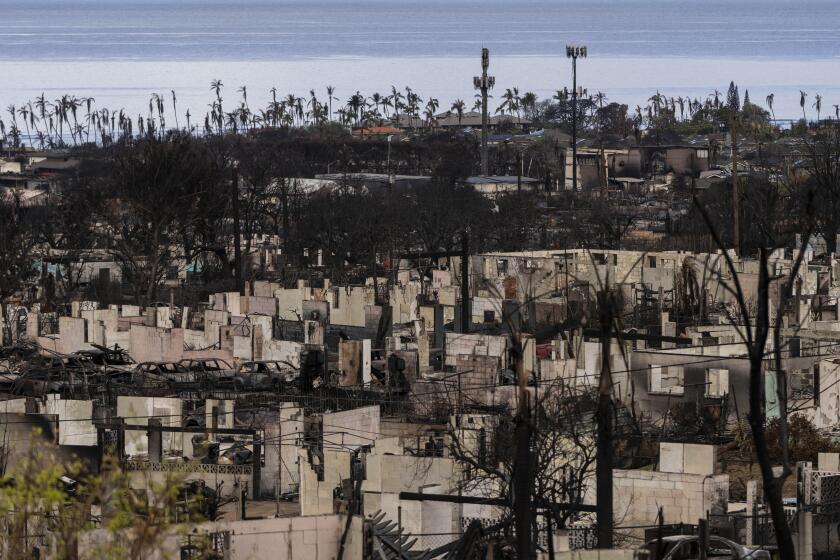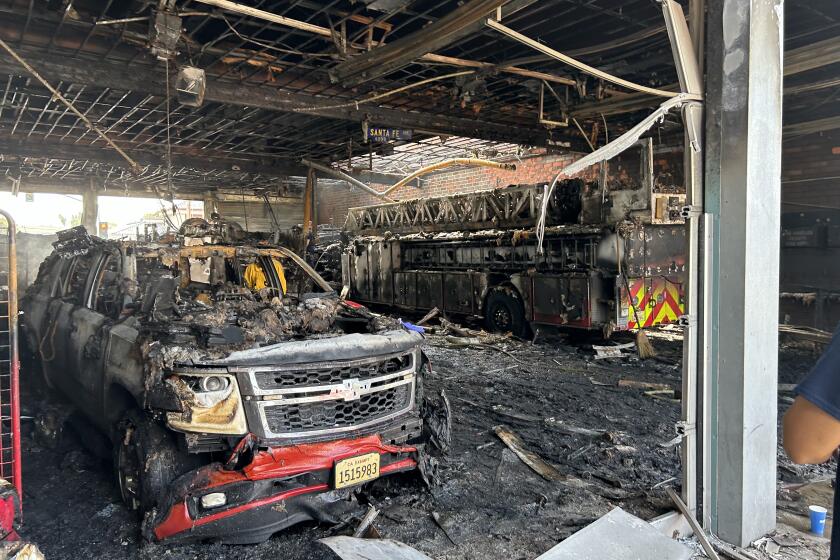Fighting for Life After a Wildfire
Dottie Knecht is on a search-and-destroy mission. She leads a team scouting the charred edges of the paved road that cuts through a forest of burned-out ponderosa pines, yanking weeds and stuffing them into black plastic trash bags.
The botanist offers a vivid account of the unwanted plants. The tall ones with the urn-shaped pink flowers are knapweed. They’re bad. The beautiful but diabolical bearded creeper--crupina vulgaris--spreads quickly in soil denuded by fires. They’re worse.
Getting rid of these weeds, Knecht says, is among the most pressing tasks after a forest fire. Left to their own biological imperatives, noxious weeds--called bombs by botanists--will detonate in burned areas, flourish and crowd out native plants essential to wildlife and the forest ecosystem.
“It’s pretty simple,” she said, pointing at the despised plants. “They want to live, and we want them to die.”
The Goal is Forest’s Recovery in Long Term
When lightning ignited a late summer fire in the 4-million-acre Okanogan and Wenatchee national forests, nearly 1,000 firefighters responded from across the country. But Knecht and a handful of her colleagues were not there to put out the so-called Icicle Complex fire.
As members of BAER teams--Burn Area Emergency Rehabilitation--Knecht and other U.S. Forest Service scientists and engineers had a very different job: Their goal was to figure out the best way to undo the damage caused by the blaze and the firefighters, who often redirect streams and cut trees to put out the blaze.
In the early days of a wildfire, suppression is the top priority. But ecologists say it is the work of BAER teams that will ultimately determine the long-term health of a forest’s massive ecosystem.
The BAER teams’ jobs begin almost as soon as the wildfire breaks out. In a cavernous fish hatchery building that serves as the Icicle fire’s base camp, rehab specialist Heather Murphy scans the fire incident map. Fire maps are dense, complicated documents bristling with coded symbols--stars, dots, intricate cross-hatching and solid and broken lines--that tell a fast-changing story of wildfire management.
But when Murphy reads this map, she sees a universe apart from the fire. A wildlife biologist, Murphy sees habitat, soil, roads and watersheds, all in imminent danger--both from the fire and the firefighting efforts.
The first phase of rehabilitation begins while the fire is burning. Murphy alerts fire bosses to the endangered species in the forest, requiring helicopter pilots to change flight plans to avoid Peregrine falcons. In a previous fire, Murphy hiked up near a pair of nesting Northern spotted owls and installed a decibel meter to determine whether aerial tankers were disturbing the endangered birds.
The BAER team suggests ways to save this valley’s water supply and instructs that fire-retardant chemicals not be released near rivers. They fret about rocky hillsides that are likely to crumble after the first big rainfall. They consider what future runoff sediment might mean to the fisheries.
And then there are the weeds, considered toxic waste. The rehab specialists order that all firefighters and machines in the fire zone be checked daily for clinging seeds to prevent their spread. On one recent fire, 60,000 feet of fire hose had to be abandoned in the forest because it was impaled with thousands of barbed weed seeds.
Restoring Habitat of Critical Creatures
Once the fire burns out, new crews descend on the forest to carry out the rehab team’s strategy to restore the forest’s health.
Up a charred canyon and along a washboard dirt road, three men labor to save a small meadow. They are working to return the field--scraped level to serve as a safety zone for firefighters--to its natural state.
The excavator operator, a former logger put out of business by the spotted owls in this forest, folds topsoil back onto the denuded ground. He’s restoring the endangered bird’s habitat.
Two others use small shovels to transplant alder trees on the edge of the clearing. They’re shoring up the loose soil.
The crew works against nature’s seasonal clock: Unless plants can gain a foothold in the soil soon, they will be washed away in the fall rainstorms, along with much of the mountainside.
Throughout the 8,000-acre burned area, the fire and the firefighting have left damaging footprints. The fire camp--a vast sea of small tents with gear strewn about--has turned a meadow into bare, hard-packed ground. That, along with a field used as a helicopter pad, must be plowed and replanted.
Down valley, Don Muise is leading a crew up a steep trail looking for hot spots amid ferns and charred ponderosa pines. The forest floor smells like a fireplace. Muise, a forest ranger from New Hampshire, points out the damage his crew has done by gouging out a firebreak. They will repair the damage, he explains, by refilling the trench with the same material that was removed to make it.
“Rehab work is not what you sign up for, it’s not what gets the adrenaline going,” he said, his sooty face splitting into a smile. “But it’s important.”
Mudslides, Boulders Loom as a Threat
The primary rehab concerns on the Icicle Complex fire are soil erosion and protection of the watershed.
“The entire valley gets water from this drainage,” said Greg Thayer, a recreation specialist with the forest. “If we screw things up, they are going to be in a world of hurt.”
There are several problems. The steep rocky hillsides, prized by rock climbers, cannot be planted and will most certainly shear off with significant rain. That cascade of boulders will clog roads.
And sometimes front yards. Carl Davis, a soil scientist who is the BAER team leader, pinpoints the trouble on yet another map. This area, he jabs a finger to emphasize, “will be rock pile and debris.”
Davis points at the spot where 60 homeowners live on private land within the forest. They are in harm’s way should heavy rains drag boulders down on them.
There is nothing they can do to prevent portions of the mountains from shearing off. Yet Davis and his team search for ways to lessen the effect of this natural occurrence, to protect homeowners from rocks roaring down the canyons and to avert massive flooding, which has taken lives here after previous fires.
The situation illustrates the limitations of BAER work. Not every part of every forest can be saved.
“I would tell these people to store valuables and important things somewhere else for five years,” Davis said, stone-faced. “We feel if we can get them through five years, we will have dodged a bullet.”
More to Read
Start your day right
Sign up for Essential California for news, features and recommendations from the L.A. Times and beyond in your inbox six days a week.
You may occasionally receive promotional content from the Los Angeles Times.







